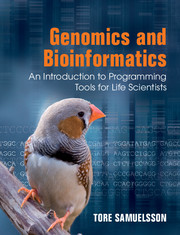Book contents
- Frontmatter
- Contents
- Preface
- Acknowledgements
- Design and conventions of this book
- 1 Introduction: working with the molecules of life in the computer
- 2 Gene technology: cutting DNA
- 3 Gene technology: knocking genes down
- 4 Gene technology: amplifying DNA
- 5 Human disease: when DNA sequences are toxic
- 6 Human disease: iron imbalance and the iron responsive element
- 7 Human disease: cancer as a result of aberrant proteins
- 8 Evolution: what makes us human?
- 9 Evolution: resolving a criminal case
- 10 Evolution: the sad case of the Tasmanian tiger
- 11 A function to every gene: termites, metagenomics and learning about the function of a sequence
- 12 A function to every gene: royal blood and order in the sequence universe
- 13 A function to every gene: a slimy molecule
- 14 Information resources: learning about flu viruses
- 15 Finding genes: going ashore at CpG islands
- 16 Finding genes: in the world of snurpsp
- 17 Finding genes: hunting for the distant RNA relatives
- 18 Personal genomes: the differences between you and me
- 19 Personal genomes: what’s in my genome?
- 20 Personal genomes: details of family genetics
- Appendix I Brief Unix reference
- Appendix II A selection of biological sequence analysis software
- Appendix III A short Perl reference
- Appendix IV A brief introduction to R
- Index
- References
13 - A function to every gene: a slimy molecule
Published online by Cambridge University Press: 05 August 2012
- Frontmatter
- Contents
- Preface
- Acknowledgements
- Design and conventions of this book
- 1 Introduction: working with the molecules of life in the computer
- 2 Gene technology: cutting DNA
- 3 Gene technology: knocking genes down
- 4 Gene technology: amplifying DNA
- 5 Human disease: when DNA sequences are toxic
- 6 Human disease: iron imbalance and the iron responsive element
- 7 Human disease: cancer as a result of aberrant proteins
- 8 Evolution: what makes us human?
- 9 Evolution: resolving a criminal case
- 10 Evolution: the sad case of the Tasmanian tiger
- 11 A function to every gene: termites, metagenomics and learning about the function of a sequence
- 12 A function to every gene: royal blood and order in the sequence universe
- 13 A function to every gene: a slimy molecule
- 14 Information resources: learning about flu viruses
- 15 Finding genes: going ashore at CpG islands
- 16 Finding genes: in the world of snurpsp
- 17 Finding genes: hunting for the distant RNA relatives
- 18 Personal genomes: the differences between you and me
- 19 Personal genomes: what’s in my genome?
- 20 Personal genomes: details of family genetics
- Appendix I Brief Unix reference
- Appendix II A selection of biological sequence analysis software
- Appendix III A short Perl reference
- Appendix IV A brief introduction to R
- Index
- References
Summary
Extensive sugar decoration
In the two previous chapters we dealt with problems of assigning function to proteins or protein domains. We concerned ourselves with methods relying on sequence similarity, i.e. methods based on local alignment or profiles. We will now see an example of a functional domain which is not easily identified on the basis of sequence similarity or with profiles. It has specific properties as it has a characteristic amino acid composition and functional properties based on that composition. However, the properties of the domain may not be captured on the basis of sequence alignment or by position-specific information. The domain in question is characteristic of a group of proteins referred to as mucins (Perez-Vilar and Hill, 1999; Hollingsworth and Swanson, 2004).
A characteristic property of all mucins is the ability to form gels. Mucins are a major component of the mucous layer that is present on the surface of epithelial cells of the lung and intestine. The proteins act as a diffusion barrier to prevent harmful microorganisms and substances having more intimate contact with the cell. Mucins also function as lubricants to protect epithelial cells from dehydration and physical and chemical injury. Because mucins protect against pathogens, they play an important role in immune defence. In addition, certain mucins are associated with colon cancer (Hollingsworth and Swanson, 2004) and there is a strong association between the mucin Muc2 and the inflammatory bowel disease ulcerative colitis. For example, inflammation of the large intestine similar to ulcerative colitis is observed in mice that are deficient in the mucin Muc2 (Heazlewood et al., 2008).
Information
- Type
- Chapter
- Information
- Genomics and BioinformaticsAn Introduction to Programming Tools for Life Scientists, pp. 164 - 172Publisher: Cambridge University PressPrint publication year: 2012
